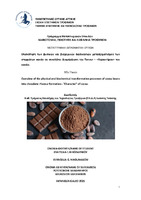| dc.contributor.advisor | LOUGOVOIS, VLADIMIROS | |
| dc.contributor.author | Νικολαράκου, Ευαγγελία | |
| dc.date.accessioned | 2021-08-26T19:10:38Z | |
| dc.date.available | 2021-08-26T19:10:38Z | |
| dc.date.issued | 2021-07-29 | |
| dc.identifier.uri | https://polynoe.lib.uniwa.gr/xmlui/handle/11400/1105 | |
| dc.identifier.uri | http://dx.doi.org/10.26265/polynoe-956 | |
| dc.description.abstract | Η παρούσα μεταπτυχιακή εργασία έχει ως αντικείμενο μελέτης τις φυσικές και βιοχημικές διεργασίες που λαμβάνουν χώρα κατά το μετασχηματισμό κόκκων κακάο σε σοκολάτα και την επίδρασή τους στη διαμόρφωση του ιδιάζοντος flavour του προϊόντος. Η γνωστή σοκολάτα υγείας παρασκευάζεται με ανάμιξη βουτύρου κακάο και σκόνης κακάο σε διαφορετικές αναλογίες, ενώ η σοκολάτα γάλακτος περιέχει επίσης συμπυκνωμένο γάλα ή γάλα σε σκόνη. Το κακάο αποτελεί πλούσια πηγή φυτικών ινών (40-26%), λιπιδίων (24-10%), πρωτεϊνών (20-15%), υδατανθράκων (15%), ιχνοστοιχείων, βιταμινών (A, B, E) και ανόργανων αλάτων (P, Ca, K, Na, Mg, Zn, Cu). Το άρωμα κακάο οφείλεται σε ένα κλάσμα 600 και πλέον πτητικών ενώσεων που περιλαμβάνουν αλδεΰδες, κετόνες, φουράνια, φαινόλες, αλκοόλες, οξέα, πυραζίνες, θειαζόλες, εστέρες, αιθέρες, κλπ. Οι ενώσεις αυτές σχηματίζονται κατά τη φρύξη από πρόδρομες ενώσεις που παράγονται στη διάρκεια της ζύμωσης των σπερμάτων, ευθυνόμενες για τις αρωματικές-γευστικές νότες του κακάο και των προϊόντων του (φρουτώδης, πικάντικη, ανθέων, στυπτική, όξινη, πικρή, κλπ.). Οι εμπλεκόμενοι μικροοργανισμοί (ζύμες, βακτήρια γαλακτικού και οξικού οξέος, Bacillus spp., νηματοειδείς μύκητες) αποικοδομούν σάκχαρα και αζωτούχες ενώσεις και παράγουν ελεύθερα αμινοξέα, ολιγοπεπτίδια και ανάγοντα σάκχαρα, τα οποία συμμετέχουν σε αντιδράσεις μη-ενζυμικής αμαύρωσης (Maillard) και ως εκ τούτου η συγκέντρωση και αναλογία τους είναι ζωτικής σημασίας για την ανάπτυξη του αρώματος κατά τη φρύξη των σπερμάτων. Η διαδικασία της φρύξης μειώνει την υγρασία των κόκκων, ευνοεί την οξείδωση φαινολών και την απομάκρυνση οξικού οξέος, εστέρων και άλλων ανεπιθύμητων πτητικών συστατικών, συμβάλλοντας στη ενίσχυση του αρώματος και της χαρακτηριστικής χροιάς των κόκκων. Η σύνθετη φύση και σπουδαιότητα αυτών των διαδικασιών, όσον αφορά τον αρωματικό και γευστικό χαρακτήρα των προϊόντων κακάο, δικαιολογεί το αυξημένο επιστημονικό ενδιαφέρον για την κατανόηση των υποκείμενων μηχανισμών. | el |
| dc.format.extent | 66 | el |
| dc.language.iso | el | el |
| dc.publisher | Πανεπιστήμιο Δυτικής Αττικής | el |
| dc.rights | Αναφορά Δημιουργού - Μη Εμπορική Χρήση - Παρόμοια Διανομή 4.0 Διεθνές | * |
| dc.rights | Attribution-NonCommercial-NoDerivatives 4.0 Διεθνές | * |
| dc.rights.uri | http://creativecommons.org/licenses/by-nc-nd/4.0/ | * |
| dc.subject | Σοκολάτα | el |
| dc.subject | Cocoa | el |
| dc.subject | Flavour | el |
| dc.title | Επισκόπηση των φυσικών και βιοχημικών διαδικασιών μετασχηματισμού των σπερμάτων κακάο σε σοκολάτα: Διαμόρφωση του flavour – «Χαρακτήρας» του κακάο. | el |
| dc.title.alternative | Overview of the physical and biochemical transformation processes of cocoa beans into chocolate: Flavour formation - "Character" of cocoa. | el |
| dc.type | Μεταπτυχιακή διπλωματική εργασία | el |
| dc.contributor.committee | Batrinou, Anthimia | |
| dc.contributor.committee | Giannakourou, Maria | |
| dc.contributor.faculty | Σχολή Επιστημών Τροφίμων | el |
| dc.contributor.department | Τμήμα Επιστήμης και Τεχνολογίας Τροφίμων | el |
| dc.contributor.master | Καινοτομία, Ποιότητα και Ασφάλεια Τροφίμων | el |
| dc.description.abstracttranslated | The objective of this thesis was to investigate the physical and biochemical processes that take place during the transformation of cocoa beans into chocolate and their impact on the formation of the characteristic flavour of the product. The well-known health chocolate is made by mixing cocoa butter and cocoa powder in different proportions, while milk chocolate contains condensed milk or milk powder, as well. Cocoa is a rich source of fibre (40-26%), lipids (24-10%), protein (20-15%), carbohydrates (15%), trace elements, vitamins (A, B, E) and minerals (P, Ca, K, Na, Mg, Zn, Cu). The aroma of cocoa is due to a fraction of more than 600 volatile compounds including aldehydes, ketones, furans, phenols, alcohols, acids, pyrazines, thiazoles, esters, ethers, etc.). These compounds are formed during roasting, from precursors produced during the fermentation of seeds, and are responsible for the aromatic flavour notes of cocoa and its products (fruity, spicy, floral, astringent, acidic, bitter, etc.). The microorganisms involved in this process (yeasts, lactic and acetic acid bacteria, Bacillus spp., filamentous fungi) degrade sugars and nitrogen compounds and produce free amino acids, oligopeptides and reducing sugars, which are involved in non-enzymatic browning reactions (Maillard), and their concentration and proportion are vital for the development of the aroma during the roasting of the seeds. The process of roasting reduces the moisture of the grains, promotes the oxidation of phenols and the removal of acetic acid, esters and other unwanted volatile components, thereby contributing to the enhancement of the aroma and the characteristic hue of the grains. The complex nature and importance of these processes, in terms of the aromatic and tasteful character of cocoa products, justifies the increased scientific interest in understanding the underlying mechanisms. | el |


